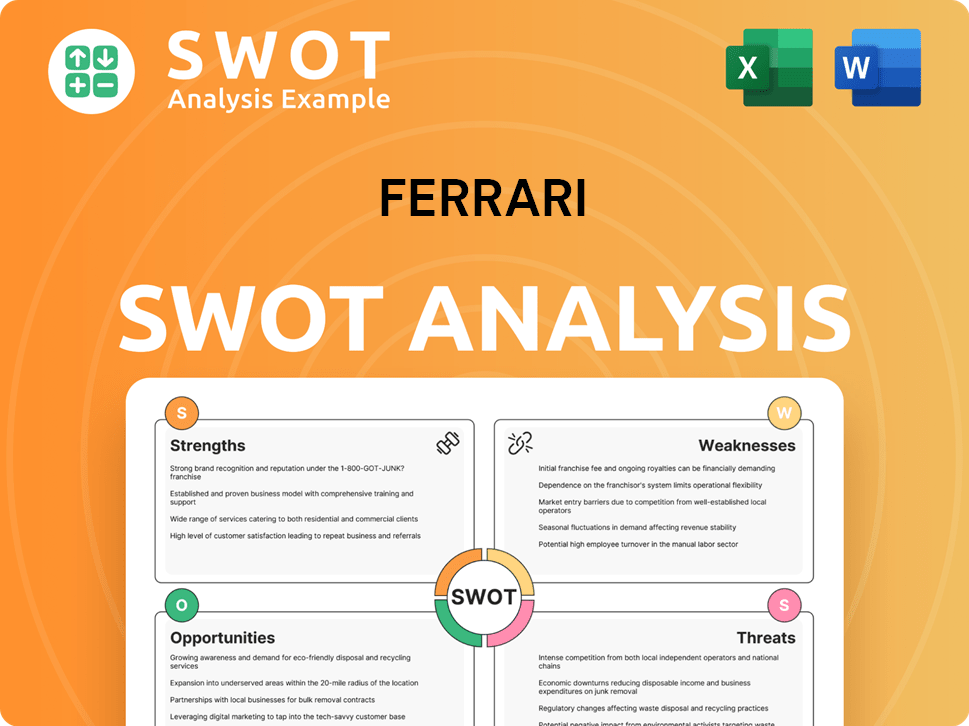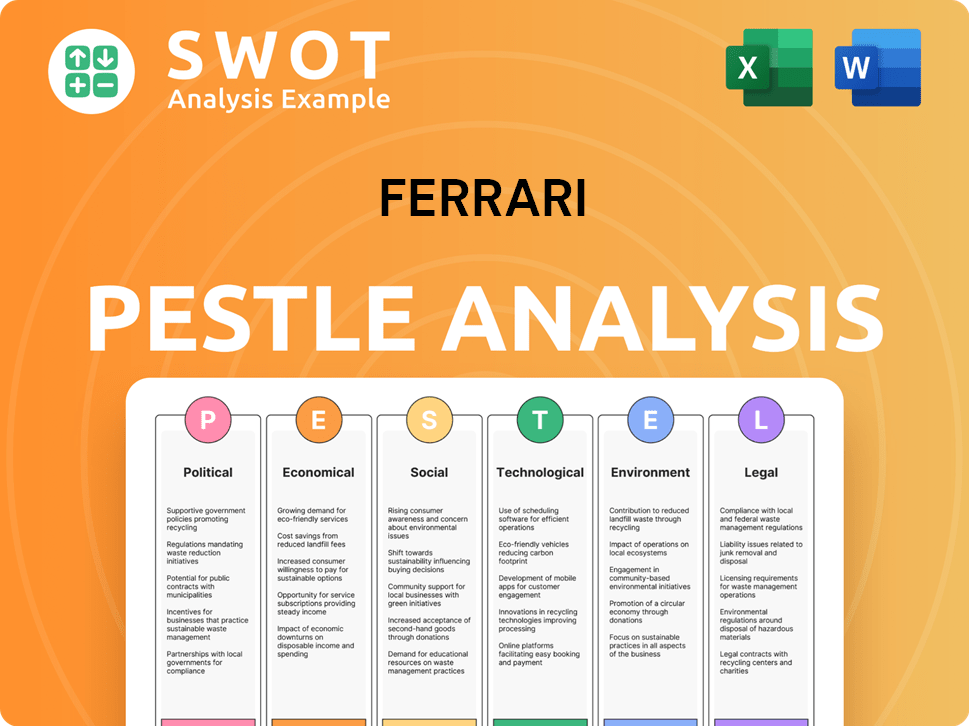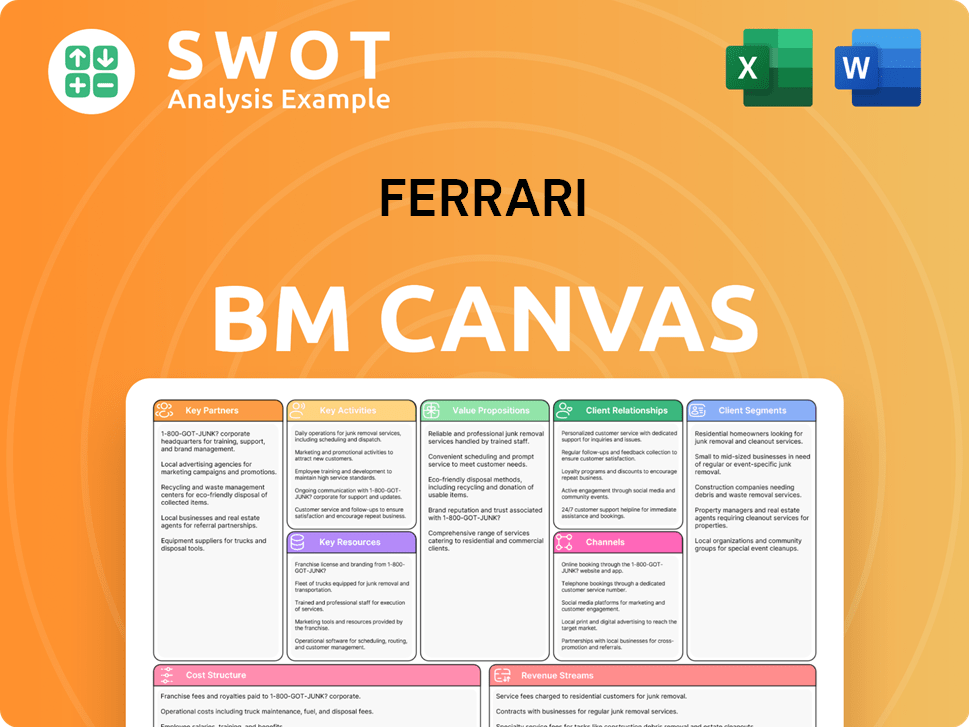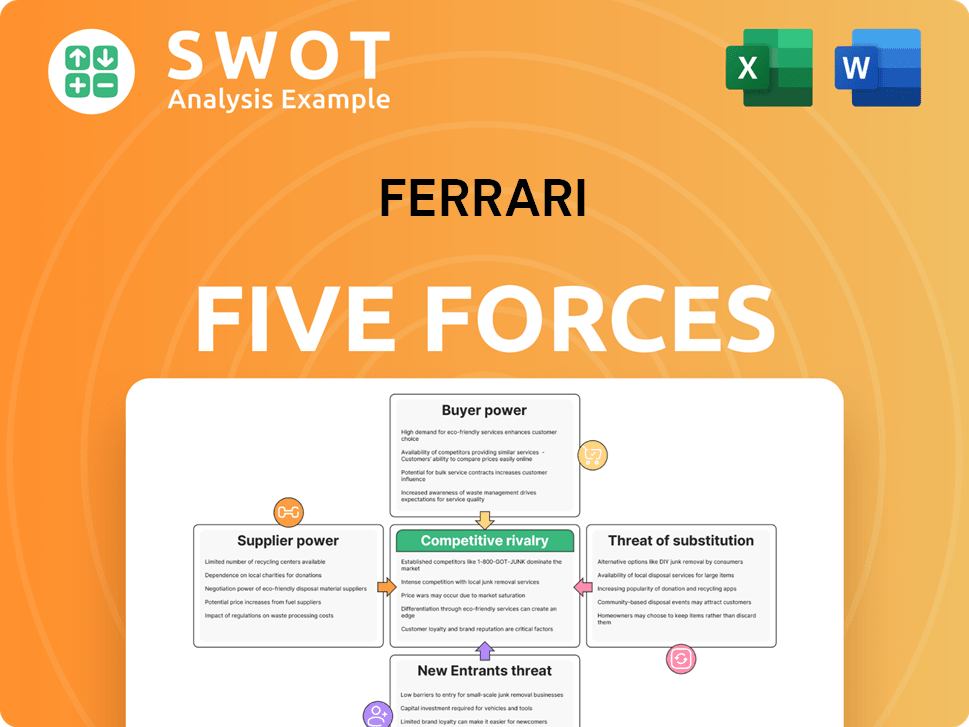Ferrari Bundle
Can Ferrari Maintain Its Pole Position in the Luxury Car Race?
Ferrari, the epitome of automotive excellence, faces a dynamic and fiercely contested Ferrari SWOT Analysis. From its legendary racing heritage to its iconic road cars, Ferrari has cultivated a brand synonymous with performance and prestige. But in today's rapidly changing luxury car market, how does Ferrari navigate its competition, and what strategies does it employ to stay ahead?

This deep dive into the Ferrari competitive landscape will uncover the company's key rivals, including Lamborghini, Porsche, and Aston Martin, and analyze their market strategies. We'll explore Ferrari's key strengths and weaknesses, its financial performance, and its approach to technological advancements and customer loyalty. This comprehensive Ferrari market analysis will provide a clear understanding of Ferrari's position in the automotive industry competition and its future prospects.
Where Does Ferrari’ Stand in the Current Market?
Ferrari occupies a unique and highly coveted position within the ultra-luxury sports car market. Its market position is characterized by exclusivity and premium pricing. While specific market share figures for this niche segment are often opaque, Ferrari consistently leads in brand recognition and desirability among its peers. The company's primary product lines include a range of high-performance sports cars, grand tourers, and limited-edition hypercars, all embodying its distinctive blend of power, design, and heritage.
Geographically, Ferrari boasts a strong global presence, with significant sales in North America, Europe, and Asia-Pacific, particularly in emerging luxury markets. Its customer base comprises ultra-high-net-worth individuals and discerning collectors who prioritize performance, exclusivity, and brand prestige. Ferrari's competitive landscape is defined by its ability to maintain its premium positioning, resisting temptations to move into broader, more accessible segments. Instead, it has strategically diversified its offerings within the luxury sphere.
Ferrari's financial health remains robust, with reported net revenues of €5.97 billion in 2023, an increase of 17.2% compared to the previous year, and a net profit of €1.257 billion in 2023. This financial strength, coupled with strong demand and carefully managed production volumes, underscores its dominant position in the luxury automotive sector. For a deeper dive into the company's origins, consider reading about the Brief History of Ferrari.
Ferrari holds a leading position in brand recognition within the ultra-luxury sports car market. While specific market share data can be limited, the brand's desirability and prestige are consistently high. This strong recognition is a key factor in the Ferrari competitive landscape.
Ferrari's product portfolio includes high-performance sports cars, grand tourers, and limited-edition hypercars. The company strategically diversifies within the luxury sphere, as seen with the Purosangue SUV. This strategy helps maintain brand exclusivity while capturing new market segments.
Ferrari has a strong global presence, with significant sales in North America, Europe, and Asia-Pacific. Its customer base comprises ultra-high-net-worth individuals and discerning collectors. These customers prioritize performance, exclusivity, and brand prestige, which shapes Ferrari's marketing campaigns.
In 2023, Ferrari reported net revenues of €5.97 billion and a net profit of €1.257 billion. This financial strength supports its dominant position in the luxury automotive sector. The company's ability to maintain high demand and manage production volumes is crucial for its future.
Ferrari's key strengths include brand prestige, exclusivity, and a focus on high-performance vehicles. The luxury car market is highly competitive, with rivals like Lamborghini, Porsche, and Aston Martin. Ferrari's brand strategy involves maintaining its premium positioning and carefully managing production volumes.
- Strong Brand Recognition: Ferrari consistently leads in brand desirability within the luxury sports car market.
- Premium Pricing Strategy: The company maintains high prices, reinforcing its exclusivity and brand image.
- Global Sales Network: Ferrari has a strong presence in key markets, including North America, Europe, and Asia-Pacific.
- Financial Stability: Robust financial performance, with increasing revenues and profits, supports its market position.
Ferrari SWOT Analysis
- Complete SWOT Breakdown
- Fully Customizable
- Editable in Excel & Word
- Professional Formatting
- Investor-Ready Format

Who Are the Main Competitors Challenging Ferrari?
The Ferrari competitive landscape is characterized by intense rivalry within the luxury car market. Several manufacturers compete directly with Ferrari, vying for market share and customer loyalty. Understanding these competitors is crucial for assessing Ferrari's position and strategic choices.
The Ferrari market analysis reveals a dynamic environment where technological advancements, brand prestige, and financial performance are key differentiators. The automotive industry competition is fierce, with each player striving to capture the attention of high-net-worth individuals and enthusiasts. A deep dive into Ferrari's rivals provides insight into the challenges and opportunities it faces.
For a comprehensive look at how Ferrari generates revenue, consider reading Revenue Streams & Business Model of Ferrari.
Ferrari's primary competitors include Lamborghini, McLaren, and Aston Martin. These brands directly challenge Ferrari in the high-performance and luxury segments. They compete on factors like performance, design, and brand heritage.
Lamborghini, owned by the Volkswagen Group, is a direct rival. It is known for its aggressive styling and powerful engines. Lamborghini's models often appeal to a customer base seeking a bolder aesthetic and extreme performance.
McLaren, with its Formula 1 heritage, focuses on technological innovation and track-focused performance. It competes with Ferrari by offering advanced engineering and a commitment to driving dynamics. McLaren's emphasis is on cutting-edge technology and racing pedigree.
Aston Martin, a British luxury automaker, competes with its grand tourers and sports cars. It emphasizes elegance, craftsmanship, and a distinguished heritage. Aston Martin targets customers who value sophisticated design and a rich brand history.
Indirect competition comes from high-end models from Porsche, particularly the 911 Turbo and GT variants. Emerging electric hypercar manufacturers also pose a challenge. These competitors offer alternative options within the luxury and performance segments.
Porsche's 911 Turbo and GT variants offer formidable performance and a strong brand legacy. They often come at a slightly lower price point than Ferrari. Porsche leverages its reputation for engineering excellence and driving pleasure.
The competitive landscape is influenced by sales figures, lap times, and the ability to attract affluent clients. Mergers and alliances within the automotive industry also play a role. These factors shape the strategies and performance of each brand.
- Sales Performance: Ferrari's sales figures are closely watched against those of Lamborghini, McLaren, and Aston Martin. For example, in 2023, Ferrari delivered over 13,663 cars worldwide, reflecting strong demand.
- Technological Advancements: Innovation in areas like hybrid and electric powertrains is critical. McLaren's focus on advanced engineering and Ferrari's development of hybrid models are key.
- Brand Prestige: The perceived value and desirability of each brand influence customer choices. Ferrari's heritage and Formula 1 involvement contribute significantly to its brand image.
- Market Share: Ferrari's market share in the luxury car market is a key indicator of its competitive position. Analyzing this data alongside competitors provides insights into market trends.
- Customer Loyalty: Customer retention rates and repeat purchases indicate brand loyalty. Ferrari's ability to maintain a loyal customer base is crucial for sustained success.
Ferrari PESTLE Analysis
- Covers All 6 PESTLE Categories
- No Research Needed – Save Hours of Work
- Built by Experts, Trusted by Consultants
- Instant Download, Ready to Use
- 100% Editable, Fully Customizable

What Gives Ferrari a Competitive Edge Over Its Rivals?
The competitive landscape for Ferrari is defined by its unique blend of brand prestige, technological prowess, and exclusivity. This combination allows the company to command premium pricing and maintain a loyal customer base. Understanding the Ferrari competitive landscape requires an analysis of its key strengths, weaknesses, and how it positions itself within the luxury car market.
Ferrari's enduring success stems from a carefully cultivated brand image and a commitment to innovation. Its heritage in motorsport, particularly Formula 1, provides a continuous source of technological advancements and brand recognition. This, coupled with meticulous craftsmanship and limited production, creates a sense of scarcity that fuels demand, setting it apart in the automotive industry competition.
The company's strategic moves, such as investing in research and development and managing its brand image, are crucial for maintaining its competitive edge. The global dealer network, providing an exclusive sales and service experience, further strengthens customer relationships. For a deeper dive into the company's stakeholders, consider exploring the insights provided by Owners & Shareholders of Ferrari.
The prancing horse logo is globally recognized, symbolizing luxury and performance. This strong brand allows Ferrari to command premium pricing. Ferrari's history, particularly its successes in Formula 1, enhances its brand mystique and customer loyalty.
Ferrari's proprietary technology and engineering expertise are key advantages. Continuous innovation, often stemming from its Formula 1 racing division, leads to cutting-edge features. This includes advancements in high-performance engines, aerodynamics, and lightweight materials.
Limited production volumes and meticulous craftsmanship enhance desirability. Each vehicle is a bespoke work of art with extensive customization options. This exclusivity creates a sense of scarcity, driving demand within the luxury car market.
Ferrari cultivates strong customer relationships through its selective global dealer network. This network provides an exclusive sales and service experience. This approach strengthens customer loyalty and supports the brand's premium positioning.
Ferrari's competitive advantages are multifaceted, including brand equity, technological innovation, and exclusivity. These factors allow Ferrari to maintain a strong position in the luxury car market. Ferrari's market analysis reveals a focus on high-performance vehicles and a commitment to maintaining its brand image.
- Brand Heritage: The prancing horse logo is instantly recognizable worldwide.
- Technological Leadership: Innovations from Formula 1 translate to road cars.
- Exclusivity: Limited production and bespoke customization enhance desirability.
- Customer Experience: The dealer network provides exclusive sales and service.
Ferrari Business Model Canvas
- Complete 9-Block Business Model Canvas
- Effortlessly Communicate Your Business Strategy
- Investor-Ready BMC Format
- 100% Editable and Customizable
- Clear and Structured Layout

What Industry Trends Are Reshaping Ferrari’s Competitive Landscape?
The Marketing Strategy of Ferrari is significantly shaped by the dynamic shifts in the luxury automotive industry. This sector is experiencing considerable transformation driven by trends like electrification, personalization, and digital integration. These changes present both challenges and opportunities for the company, influencing its competitive landscape and future outlook.
The luxury car market is highly competitive, with several established and emerging players vying for market share. Understanding the industry trends, future challenges, and opportunities is crucial for Ferrari to maintain its position. The company must strategically adapt to these changes to ensure continued success in the evolving automotive landscape.
The luxury automotive industry is experiencing significant shifts. Electrification is a major trend, driven by both regulatory pressures and consumer demand. Personalization and digital integration are also key, with customers expecting highly customizable vehicles and seamless connectivity. These trends require strategic adaptation from manufacturers to stay competitive.
Ferrari faces several challenges. Intensifying competition from new electric hypercar manufacturers is a concern. Potential shifts in luxury consumer preferences towards more sustainable options and the rising costs of advanced automotive technologies pose further challenges. Geopolitical instability and economic downturns could also impact the target demographic's disposable income.
Significant opportunities exist for Ferrari. Expanding into emerging luxury markets, particularly in Asia, is a key area for growth. Product diversification, such as the Purosangue, can open new revenue streams. Continued innovation in sustainable materials and advanced driver-assistance systems also presents opportunities for product differentiation and market leadership.
Ferrari's competitive position is evolving. The company aims to leverage its brand heritage and exclusivity. It is investing heavily in new technologies to maintain performance leadership. The strategy focuses on appealing to a new generation of luxury buyers while navigating the transition to electrification and digital transformation. Ferrari's market share is a key indicator of its success.
Several factors are crucial for Ferrari's future. The transition to electric vehicles, the ability to maintain brand exclusivity, and innovation in technology and design are paramount. Successful navigation of these factors will determine Ferrari's ability to compete effectively in the luxury car market.
- Electrification: Ferrari plans its first fully electric model by 2025.
- Market Expansion: Focus on growth in Asia and other emerging markets.
- Product Diversification: The Purosangue launch expands market reach.
- Technological Advancement: Investments in sustainable materials and driver-assistance systems.
Ferrari Porter's Five Forces Analysis
- Covers All 5 Competitive Forces in Detail
- Structured for Consultants, Students, and Founders
- 100% Editable in Microsoft Word & Excel
- Instant Digital Download – Use Immediately
- Compatible with Mac & PC – Fully Unlocked

Related Blogs
- What are Mission Vision & Core Values of Ferrari Company?
- What is Growth Strategy and Future Prospects of Ferrari Company?
- How Does Ferrari Company Work?
- What is Sales and Marketing Strategy of Ferrari Company?
- What is Brief History of Ferrari Company?
- Who Owns Ferrari Company?
- What is Customer Demographics and Target Market of Ferrari Company?
Disclaimer
All information, articles, and product details provided on this website are for general informational and educational purposes only. We do not claim any ownership over, nor do we intend to infringe upon, any trademarks, copyrights, logos, brand names, or other intellectual property mentioned or depicted on this site. Such intellectual property remains the property of its respective owners, and any references here are made solely for identification or informational purposes, without implying any affiliation, endorsement, or partnership.
We make no representations or warranties, express or implied, regarding the accuracy, completeness, or suitability of any content or products presented. Nothing on this website should be construed as legal, tax, investment, financial, medical, or other professional advice. In addition, no part of this site—including articles or product references—constitutes a solicitation, recommendation, endorsement, advertisement, or offer to buy or sell any securities, franchises, or other financial instruments, particularly in jurisdictions where such activity would be unlawful.
All content is of a general nature and may not address the specific circumstances of any individual or entity. It is not a substitute for professional advice or services. Any actions you take based on the information provided here are strictly at your own risk. You accept full responsibility for any decisions or outcomes arising from your use of this website and agree to release us from any liability in connection with your use of, or reliance upon, the content or products found herein.